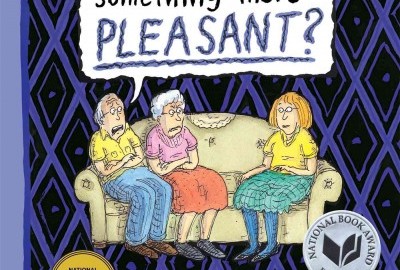
Can’t We Talk About Something More Pleasant?
Our evening book group meets on the first Monday of every month – here is a roundup of what we recently discussed. Check it out and consider joining us next month when we read Cascade by Maryanne O’Hara.
Many in the evening book group were surprised at how much they liked New Yorker cartoonist’s Roz Chast’s memoir “Can’t we talk about something more pleasant?” One member said “It broke my heart – it was too damn real.” Another identified with the author – “I saw myself in her.” The graphic novel format was amazingly effective at conveying the emotions surrounding the care and feeding of elderly parents. While this book followed Chast’s relationship with her parents until their death, it was not ultimately a downer. There were lots of laugh-out-loud moments in the book and so much energy and emotion in the drawings. Chast has a self-deprecating sense of humor and she was very easy to relate to. All felt that the format was very effective for the subject matter.
Paraphrasing one member’s comments: A graphic novel can capture things that are difficult to capture verbally, the format gives you the space to experience your own grief at a distance. You are able to breathe while reading. You read and experience it as you choose to.
Most admired Chast for her honesty and bravery and for really putting herself out there. She shared moments that were personally revealing and not always flattering. We read about her anxiety, her fears, her feelings of being removed from what was happening and her shame over not feeling or doing enough. What we do not hear about is how her husband and children coped at this time in her life. As an author she chose to exclude their story from this memoir. There was some speculation that the book was a form of self-help for the author and it was intensely HER story. She may also have wanted to preserve the privacy of her husband and children by not integrating them into the memoir.
There was admiration for Chast’s drawing style – how she could convey a world of emotions in a simple line drawing and how when the book moved into a darker phase, she was able to change her art to more realistic depictions. The sketches she made of her dying mother were particularly noted as they were so different. As one member said –“There was an honesty to them. The mother was not a hero or a saint, not an angel, just human and real.” The time Chast spent drawing her mother over and over brought her closer to her mother – One member commented “The more you draw ,the more you love what you draw.”
Chast’s parents were together alone for 40 years in the same apartment. They had their ups and downs and the mother’s relationship with Chast was complicated and not always pleasant. Her parents had a codependent relationship that germinated during the Depression era and their frugality and pack rat mentality was a product of that time. We loved seeing the actual photos of the collection of jar lids, the multiple pocketbooks, the ancient gauze bandages and jar of petroleum jelly. You never know when you might need them. We understood the father’s obsession and anxiety with his attaché case of bank books grew out of a time when pennies were dearly counted and tensions were high.
Book Group members appreciated reading about the isolation and frustrations of being the caregiver — the self-doubt, the guilt she felt when she just wanted to give up, the wish that it would all just be over because it was so difficult. For those who are caring for or had cared for and lost a loved one – hearing that those feelings were natural and common was a help.
The inclusion of the actual photos of the parents and saved objects and poems the mother wrote connected us to the memoir in a more concrete way and were a nice accent to the comic drawings. Reading this book naturally spawned conversations about our own parents and the losses we have all endured. We spoke about the emotions tied to objects- how for many of us we imbue them with memories and they can feel like a valued link to the past. This was compared to an immigrant’s experience of fleeing without anything so that objects –things-stuff lose their value and become less symbolic and important.
We also discussed the cultural and ethnic differences in expectations for the caretaking of our elders – how those expectations have changed over the years and we all have begun to live longer. One member said “They say it costs more to die than it does to live.” Another member said – “Can’t we talk about something more pleasant?”
Here is a preliminary list of other graphic novel memoirs you might also enjoy –
Fun Home: A Family Tragicomic by Alison Bechdel
Relish: My Life in the Kitchen by Lucy Knisley
Hyperbole and a Half: Unfortunate Situations, Flawed Coping Mechanisms, Mayhem, and Other Things That Happened by Allie Brosh
Stitches: A Memoir by David Small
Additional books mentioned by readers uring our Monday Evening book group:
The Secret Chord by Geraldine Brooks
Career of Evil by Robert Galbriath (aka J.K. Rowling)
The Short and Tragic Life of Robert Peace by Jeff Hobbs
Did You Ever Have a Family by Bill Clegg
Numero Zero by Umberto Eco
The Unlikely Pilgrimage of Harold Fry by Rachel Joyce
The Hare with the Amber Eyes by Edmund de Waal
A Confederacy of Dunces by John Kennedy Toole
The Leftovers by Tom Perrotta
The Year of Magical Thinking by Joan Didion
Movies and TV series mentioned included:
Bosch – the Harry Bosch series






